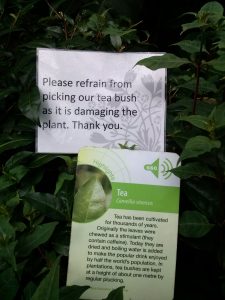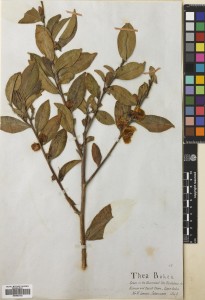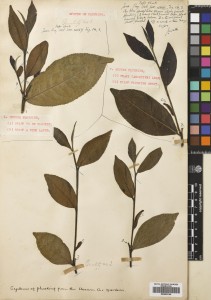Everyone loves a good cup of tea – as evidenced from our Assam tea bush in the Temperate Glasshouse at Edinburgh. 
As well as living plants at the Royal Botanic Garden Edinburgh we have, lurking in herbarium cabinets, some amazing historic Tea specimens.
James McNabs’s teaching specimens.
These two specimens would have been used to for teaching the Botany students from Edinburgh University who had classes here at RBGE. James and Professor John Hutton Balfour’s specimens were donated to and formed the nucleus of the herbarium in the Museum of Economic Botany that RBGE once had.
Unlike many herbarium specimens where the annotations are often illegible scribbles, McNab’s are beautifully annotated.

Camellia sinensis. Collected on Government plantations in 1849 by W. Jameson.
Kumaon, and Deyrah Dhoon, Saharunpore
![Demonstrating the different grades of Tea. Specimen collected by Sir John Robison, 1841 on the Dinjoy [tea] Plantation, Assam, India](http://stories.rbge.org.uk/wp-content/uploads/2014/06/E00683150_3-216x300.jpg)
Demonstrating the different grades of Tea. Specimen collected by Sir John Robison, 1841 on the Dinjoy [tea] Plantation, Assam, India
The specimen from 1841 (left) shows different grades of tea with some familar terms likes Pekoe and Twankay for black teas to less familiar ones like Imperial and Gunpowder for green teas. The leaves on this specimen came from the Tea Garden at Dinjoy in Assam in NE India which still produces tea today.
Sir George Watt’s Tea specimens
George Watt’s tea specimens were used as part of his researches into tea as part of his role as an economic botanist in British India. He was first to describe the different varieties that we drink. These featured in an article in the Journal of Royal Horticultural Society called Tea and the Tea plant.
![Collected by Sir George Watt in 1882. Inhabiting the ranges East of Manipur a little to the south of the [illegible] peak. A tree 50 feet in height. Was passing on forced marches through abd intending to return took no specimens except one twig. Fruits only when it attains a height of 20 feet or more.](http://stories.rbge.org.uk/wp-content/uploads/2014/06/E00683131_3-204x300.jpg)
Collected by Sir George Watt in 1882. Inhabiting the ranges East of Manipur a little to the south of the [illegible] peak.
A tree 50 feet in height. Was passing on forced marches through abd intending to return took no specimens except one twig. Fruits only when it attains a height of 20 feet or more.
The specimens on the right captured the system of “plucking” the tips of the tea bushes. George Watt annotated these to show various characters that appear as a result of having the tips picked. The specimens also shows two different qualities of tea, the upper two are considered better quality because of the compact grown habitat and the bottom two are a poorer quality because of the elongated shoots.
On specimen on the the left is a wild Camellia sinensis var. assamica (Assam tea plant) collected during fieldwork he undertook as part of the commission to demarcate the border between India and Burma.
All this talk of tea I think its time to put the kettle on.


2 Comments
2 Pingbacks